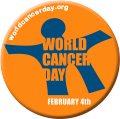Cancer &NCDs &Treatment Bill Brieger | 02 Feb 2014 06:06 am
Malaria and Cancer: World Cancer Day on 4th February
 As World Cancer Day approaches it is worth considering the connections between communicable and non-communicable diseases. Below are some brief extracts from recent studies that show relationships between malaria and cancers when it comes to diagnostics, drug research, treatment, prevention and epidemiology.
As World Cancer Day approaches it is worth considering the connections between communicable and non-communicable diseases. Below are some brief extracts from recent studies that show relationships between malaria and cancers when it comes to diagnostics, drug research, treatment, prevention and epidemiology.
PLoS One has a new article entitled: “Sloth Hair as a Novel Source of Fungi with Potent Anti-Parasitic, Anti-Cancer and Anti-Bacterial Bioactivity.” The authors found that, “Seventy-four isolates were cultivated in liquid broth and crude extracts were tested for bioactivity in vitro. We found a broad range of activities against strains of the parasites that cause malaria (Plasmodium falciparum) and Chagas disease (Trypanosoma cruzi), and against the human breast cancer cell line MCF-7.”
The Nature Group’s Scientific Reports sheds some more light on links between malaria and Burkitts lymphoma in the article “Relationship between Plasmodium falciparum malaria prevalence, genetic diversity and endemic Burkitt lymphoma in Malawi”. The researchers report that, “Endemic Burkitt lymphoma (eBL) has been linked to Plasmodium falciparum (Pf) malaria infection, but the contribution of infection with multiple Pf genotypes is uncertain… Further work is needed to evaluate the possible role of Pf genetic diversity in the pathogenesis of endemic BL.”
Recently KH Khan drew our attention to the fact that, “DNA vaccines against cancer, tuberculosis, Edwardsiella tarda, HIV, anthrax, influenza, malaria, dengue, typhoid and other diseases,” have been explored. It was noted that “These vaccines function by generating the desired antigen inside the cells, with the advantage that this may facilitate presentation through the major histocompatibility complex.”
 Hematologists must also deal with a variety of communicable and non-communicable diseases that affect red blood cells. According to Fedovsov and colleagues, “Hematologic disorders arising from infectious diseases, hereditary factors and environmental influences can lead to, and can be influenced by, significant changes in the shape, mechanical and physical properties of red blood cells (RBCs), and the biorheology of blood flow,” as well as broad spectrum of hematologic disorders including certain types of cancer.
Hematologists must also deal with a variety of communicable and non-communicable diseases that affect red blood cells. According to Fedovsov and colleagues, “Hematologic disorders arising from infectious diseases, hereditary factors and environmental influences can lead to, and can be influenced by, significant changes in the shape, mechanical and physical properties of red blood cells (RBCs), and the biorheology of blood flow,” as well as broad spectrum of hematologic disorders including certain types of cancer.
Again in the area of drug research, Hooft van Huijsduijnen and colleagues explore the “Anticancer properties of distinct antimalarial drug classes.” Within these drug classes the researcher observed that “Several of the antimalarials tested in this study have well-established and excellent safety profiles with a plasma exposure, when conservatively used in malaria, that is well above the IC50s that we identified in this study. Given their unique mode of action and potential for unique synergies with established anticancer drugs, our results provide a strong basis to further explore the potential application of these compounds in cancer in pre-clinical or/and clinical settings.”
We need to maintain a broader vision of human health past the 2015 Millennium Development Goals and neglect neither communicable nor non-communicable diseases, but see synergies and complementarities in working on both together.